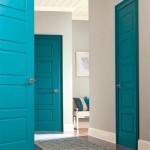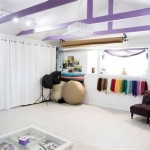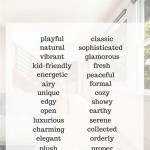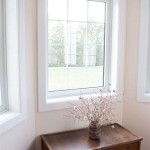Words To Describe Texture In Interior Designing
Texture, in the context of interior design, refers to the tactile quality of a surface. It is a crucial element that contributes significantly to the overall aesthetic and ambiance of a space. Texture can be real, as in the physical feel of a material, or implied, created visually through patterns and designs. Understanding and effectively utilizing textural variations is essential for creating visually appealing and emotionally resonant interiors. This article will explore various descriptive words that can be used to articulate the texture of different elements within an interior design scheme, providing a comprehensive vocabulary for designers and enthusiasts alike.
The language used to describe texture is critical in communicating design concepts, specifying materials, and ultimately realizing the intended feel of a space. Selecting the right words can evoke the desired sensory experience and help clients and collaborators understand the vision for a particular room or building. A nuanced understanding of this vocabulary allows for more precise communication and better design outcomes.
Texture can be broadly categorized into visual and tactile types. Visual texture relies on the use of patterns, color variations, and light and shadow to create the illusion of texture. Tactile texture, on the other hand, is experienced through touch and is a direct result of the material's physical properties. Both types contribute to the overall textural landscape of an interior and should be considered in the design process.
Describing Smooth Textures
Smooth textures often evoke feelings of elegance, sophistication, and cleanliness. They are generally associated with a modern aesthetic and can contribute to a sense of spaciousness and light reflection. Materials with smooth textures include polished concrete, glass, metal, and certain types of fabrics.
Specific words to describe smooth textures include:
- Sleek: Suggests a modern, streamlined, and often minimalist aesthetic. It implies a refined and sophisticated smoothness, often found in materials like polished metal or lacquered wood.
- Polished: Indicates a surface that has been treated to achieve a high degree of smoothness and reflectivity. This term is frequently used for stone, metal, and wood.
- Glossy: Describes a surface that reflects light strongly, creating a shiny appearance. It is often used for surfaces coated with varnish or enamel.
- Silky: Implies a soft and luxurious smoothness, reminiscent of silk fabric. It suggests a delicate and refined tactile experience.
- Lustrous: Similar to glossy, but often used to describe materials with a softer, more subtle sheen, such as satin or pearl.
- Refined: Conveys a sense of carefully crafted smoothness, often implying attention to detail and high quality.
- Even: Simply describes a smoothness free from bumps, ridges, or irregularities. It focuses on the uniformity of the surface.
- Uniform: Similar to even, emphasizing the consistent smoothness across the entire surface.
- Feathered: Useful when describing gradual transitions in texture. It suggests a subtle and blended smoothness.
For example, one might describe a kitchen countertop as "sleek and polished granite," conveying a sense of modern elegance and durability. Alternatively, silk curtains could be described as "silky and lustrous," highlighting their luxurious and delicate appearance.
Describing Rough Textures
Rough textures often convey feelings of warmth, rusticity, and naturalness. They can add depth and dimension to a space and create a sense of tactile interest. Materials with rough textures include exposed brick, natural stone, reclaimed wood, and certain types of fabrics like burlap or tweed.
Specific words to describe rough textures include:
- Rustic: Implies a natural, unrefined, and often aged appearance. It suggests a connection to the outdoors and a sense of history.
- Weathered: Describes a surface that has been exposed to the elements and shows signs of wear and tear. It often conveys a sense of character and authenticity.
- Distressed: Similar to weathered, but often implies intentional aging or manipulation to create a worn appearance.
- Textured: A general term indicating the presence of irregularities and variations on a surface. It is often used as a starting point for more specific descriptions.
- Coarse: Describes a rough and uneven surface with large, pronounced irregularities. It suggests a robust and durable feel.
- Granular: Implies a surface composed of small grains or particles, such as sand or gravel.
- Nubbly: Describes a surface with small, rounded bumps or protrusions.
- Irregular: Highlights the lack of uniformity and the presence of unpredictable variations on a surface.
- Uneven: Similar to irregular, emphasizing the lack of a consistent plane or surface.
- Craggy: Suggests a rough, jagged, and rocky surface, often associated with natural landscapes.
For example, an exposed brick wall might be described as "rustic and weathered," highlighting its natural imperfections and aged appearance. A woven rug could be described as "coarse and textured," emphasizing its durable and tactile qualities.
Describing Soft and Supple Textures
Soft and supple textures evoke feelings of comfort, relaxation, and luxury. They are often associated with cozy and inviting spaces and can contribute to a sense of well-being. Materials with soft and supple textures include plush fabrics like velvet or cashmere, soft leather, and fluffy rugs.
Specific words to describe soft and supple textures include:
- Plush: Describes a thick, soft, and luxurious surface, often used for fabrics like velvet or carpeting.
- Velvety: Implies a soft, smooth, and luxurious texture similar to velvet fabric.
- Supple: Describes a soft and flexible material that yields easily to pressure, such as leather or certain types of fabric.
- Cushiony: Suggests a soft and yielding surface that provides comfort and support.
- Downy: Implies a soft and fluffy texture similar to feathers, often used for bedding or upholstery.
- Fluffy: Describes a light and airy texture with a soft and voluminous appearance, often used for rugs or blankets.
- Delicate: Conveys a sense of fragility and fine softness.
- Gentle: Suggests a soft and soothing texture that is pleasant to the touch.
- Resilient: Describes a texture that springs back to its original shape after being compressed, implying durability and comfort.
- Padded: Indicates a surface that has been layered with soft materials for added comfort and cushioning.
For example, a sofa might be described as "plush and velvety," emphasizing its luxurious comfort and inviting appearance. A cashmere throw blanket could be described as "soft and supple," highlighting its delicate and comforting qualities.
Describing Hard and Rigid Textures
Hard and rigid textures often convey feelings of strength, durability, and formality. They can contribute to a sense of structure and stability within a space. Materials with hard and rigid textures include concrete, stone, metal, and certain types of wood.
Specific words to describe hard and rigid textures include:
- Solid: Emphasizes the density and lack of give in a material.
- Rigid: Describes a material that is stiff and unyielding, resisting bending or deformation.
- Firm: Suggests a hard but not uncomfortably so, slightly less unyielding than rigid.
- Stiff: Similar to rigid, implying a lack of flexibility.
- Dense: Describes a material with a high mass-to-volume ratio, indicating a tightly packed structure.
- Unbending: Emphasizes the inability of a material to be bent or flexed.
- Uncompromising: Suggests a strong and unyielding quality, both physically and metaphorically.
- Angular: Describes a surface with sharp edges and corners.
- Structured: Highlights the organized and defined form of a material.
- Resistant: Implies that the material is able to withstand pressure or impact without damage.
For example, a concrete wall might be described as "solid and dense," emphasizing its strength and durability. A metal chair could be described as "rigid and angular," highlighting its structural form and industrial aesthetic.
In conclusion, a rich vocabulary for describing texture empowers designers to communicate their vision effectively and create spaces that resonate with the intended emotional impact. By considering the nuances of each descriptive word, designers can achieve a greater level of precision in their work and ultimately create more compelling and successful interior designs.

Top Interior Design Terms To Know Dictionary

Interior Design Styles 101 The Ultimate Guide To Decorating In 2025 Decorilla

Interior Design Styles 101 The Ultimate Guide To Decorating In 2025 Decorilla

Interior Design Styles 101 The Ultimate Guide To Decorating In 2025 Decorilla

Interior Design Styles 101 The Ultimate Guide To Decorating In 2025 Decorilla

Interior Design Styles 101 The Ultimate Guide To Decorating In 2025 Decorilla

Interior Design Styles 101 The Ultimate Guide To Decorating In 2025 Decorilla

The Importance Of Using Texture In Interior Design

Elevating Home Interiors A Comprehensive Guide By Lakdi Com

Discussing The 7 Elements Of Interior Design
Related Posts








